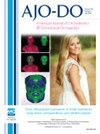Secondary alveolar bone grafting of clefts using bioactive glass 45S5: Long-term dental and periodontal status
IF 3
2区 医学
Q1 DENTISTRY, ORAL SURGERY & MEDICINE
American Journal of Orthodontics and Dentofacial Orthopedics
Pub Date : 2025-05-16
DOI:10.1016/j.ajodo.2025.04.007
引用次数: 0
Abstract
Introduction
Secondary alveolar bone grafting (SABG) restores the continuity of alveolar bone in orofacial clefts to establish a functional dental occlusion. Given the complications of autografts, the use of biomaterials has been proposed. In a previous study, we demonstrated 3-dimensional radiographic success at 1 year of >80% when bioactive glass 45S5 was used. The aim was now to establish the clinical success rate of SABG made with bioactive glass based on a combination of dental and periodontal criteria after 5 years.
Methods
This retrospective cohort study included patients who underwent SABG between 2015 and 2021 and were born before 2012. A total of 45 SABG on 35 patients was included. The mean surgical follow-up period was 5.75 years. Clinical success was defined according to a composite outcome that took into account the periodontal volume (normal or depression) at the graft level and the recession on the adjacent teeth (no recession or Miller Class I). It was studied using descriptive statistics. Subgroup analysis according to lateral incisor status and space management was performed by Fisher exact test.
Results
The clinical success rate was 71.1%. Neither the absence of a tooth close to the cleft (P = 0.845) nor the opening or closing of the space (P = 0.325) in the case of a missing tooth influenced the outcome of the procedure. Furthermore, an association was only found between radiographic and clinical success in the subgroup without missing teeth (P = 0.035). It was not found for the full cohort (P = 0.061) nor the group with missing teeth (P = 0.299).
Conclusions
The use of bioactive glass 45S5 instead of autograft is relevant for SABG, with a 5-year clinical success rate of >71%. A complete dental formula allows for a more predictable result.
生物活性玻璃45S5用于腭裂二次牙槽骨移植:长期牙齿和牙周状况。
介绍:二次牙槽骨移植(SABG)恢复牙槽骨的连续性,以建立功能性牙合。鉴于自体移植物的并发症,已经提出使用生物材料。在之前的研究中,我们证明了使用生物活性玻璃45S5时,1年bbb80 %的三维x线摄影成功率。现在的目标是在5年后基于牙科和牙周标准的结合,建立生物活性玻璃制成的SABG的临床成功率。方法:本回顾性队列研究纳入了2015年至2021年期间接受SABG手术且在2012年之前出生的患者。共纳入35例患者的45例SABG。平均手术随访时间为5.75年。临床成功是根据综合结果来定义的,该结果考虑了移植物水平的牙周体积(正常或凹陷)和相邻牙齿的凹陷(无凹陷或Miller I级)。采用描述性统计进行研究。采用Fisher精确检验对侧切牙状态和空间管理进行亚组分析。结果:临床成功率为71.1%。在缺牙的情况下,裂隙附近缺牙(P = 0.845)和间隙的打开或关闭(P = 0.325)都不影响手术的结果。此外,只有在没有缺牙的亚组中,x线摄影与临床成功之间存在关联(P = 0.035)。在整个队列(P = 0.061)和缺牙组(P = 0.299)中均未发现该现象。结论:使用生物活性玻璃45S5代替自体移植物与SABG相关,5年临床成功率为bbb71 %。完整的牙科配方可以使结果更加可预测。
本文章由计算机程序翻译,如有差异,请以英文原文为准。
求助全文
约1分钟内获得全文
求助全文
来源期刊
CiteScore
4.80
自引率
13.30%
发文量
432
审稿时长
66 days
期刊介绍:
Published for more than 100 years, the American Journal of Orthodontics and Dentofacial Orthopedics remains the leading orthodontic resource. It is the official publication of the American Association of Orthodontists, its constituent societies, the American Board of Orthodontics, and the College of Diplomates of the American Board of Orthodontics. Each month its readers have access to original peer-reviewed articles that examine all phases of orthodontic treatment. Illustrated throughout, the publication includes tables, color photographs, and statistical data. Coverage includes successful diagnostic procedures, imaging techniques, bracket and archwire materials, extraction and impaction concerns, orthognathic surgery, TMJ disorders, removable appliances, and adult therapy.

 求助内容:
求助内容: 应助结果提醒方式:
应助结果提醒方式:


